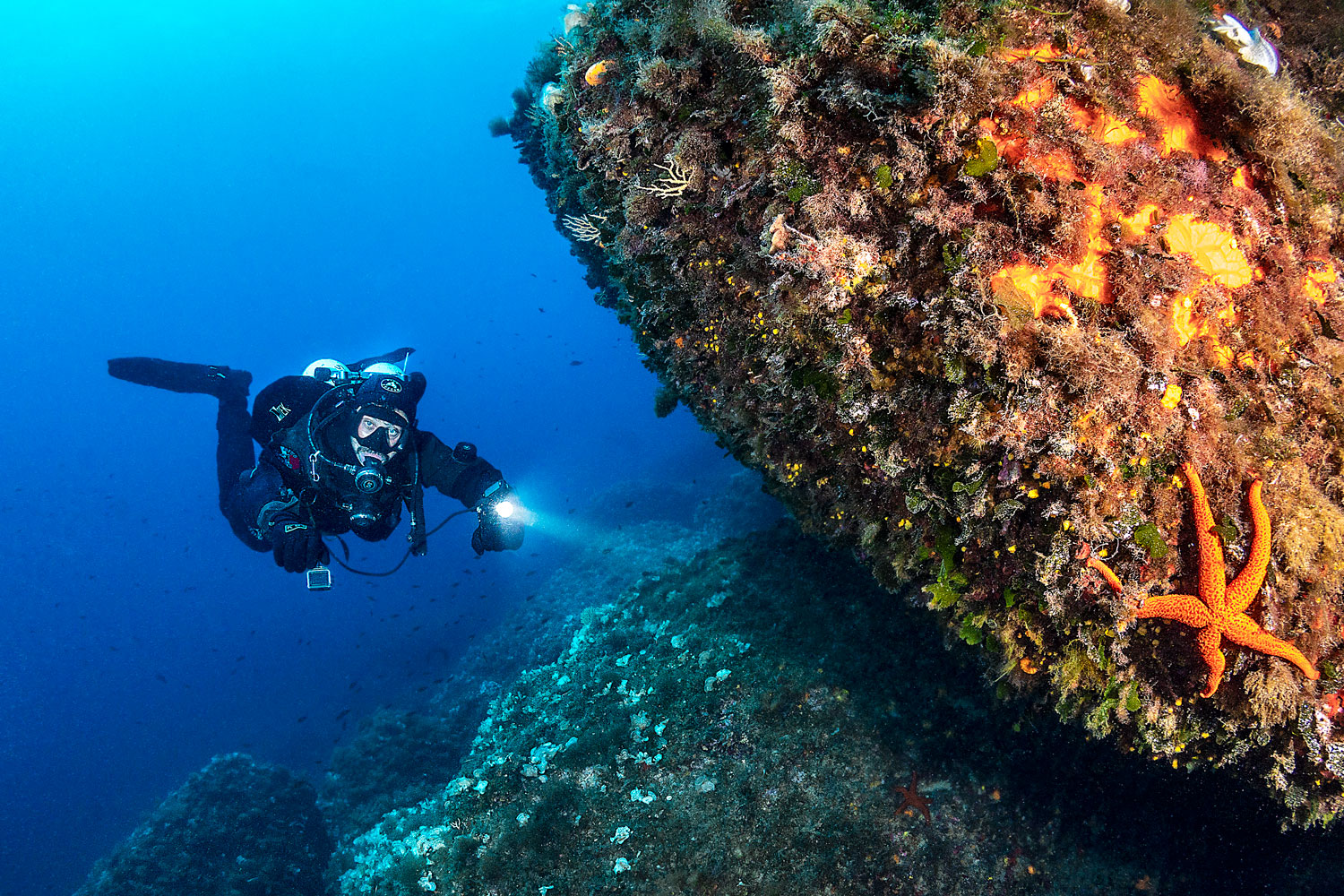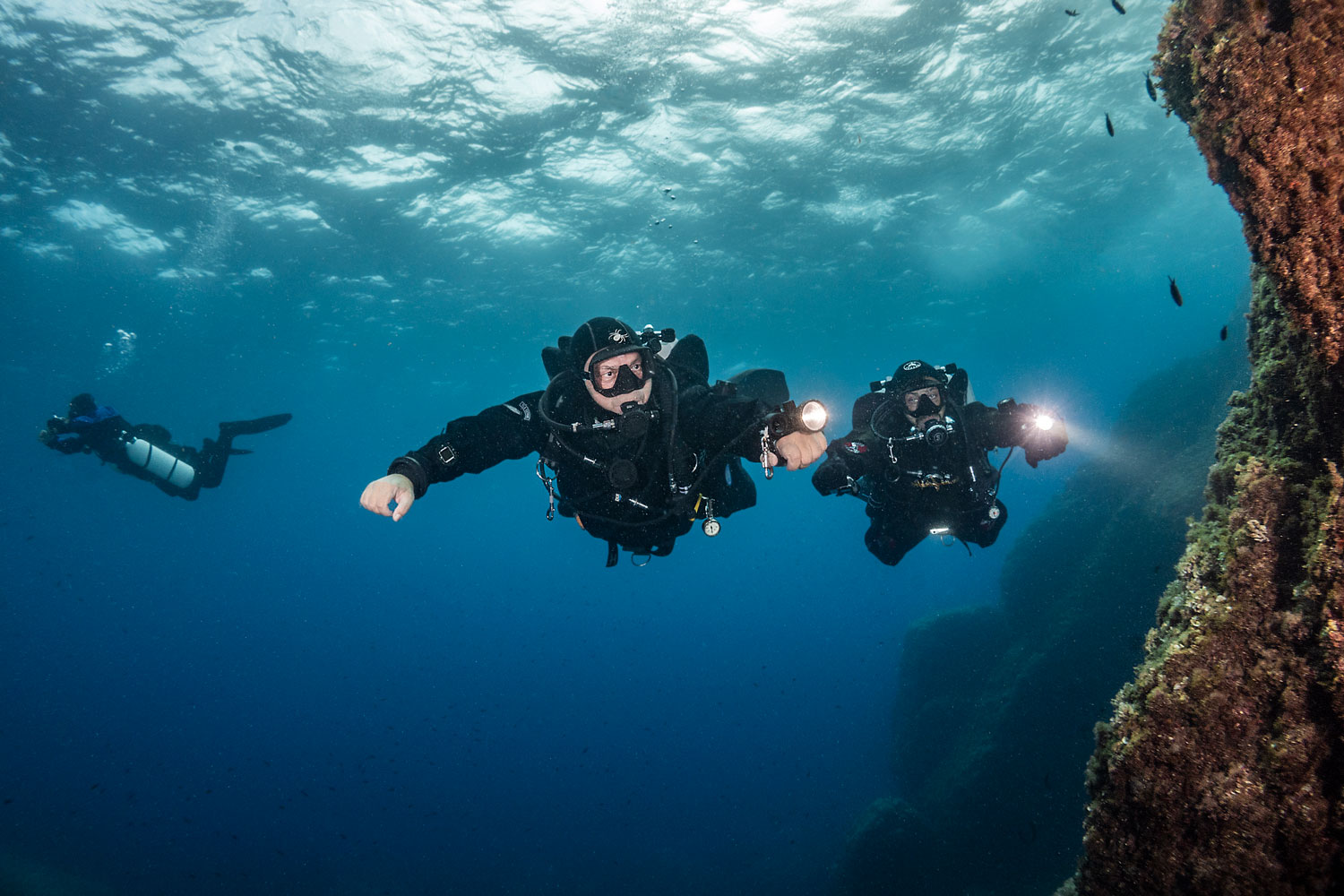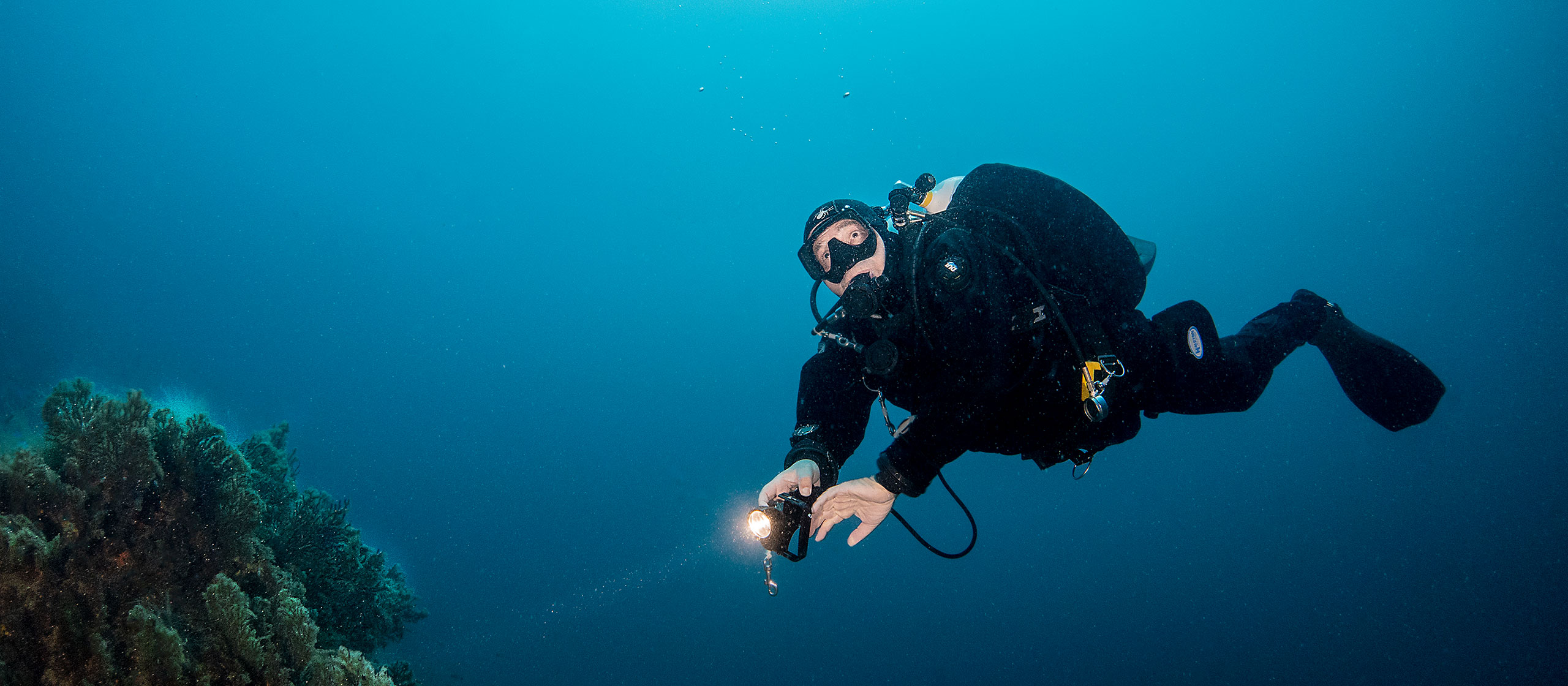Prepared diver
Managing Fear While Diving
Fear is the cold wave of emotion that can feel like a solid barrier against forward movement. One of the most primitive of human emotions, fear forms part of an adaptive reaction to danger in the environment. When threatened, our biological system offers up a range of states to support survival: freeze – flight – fight – fright – flag – faint (Schauer and Elbert, 2010). All are of only limited use underwater and can tend to create more problems that they solve. Combining these psycho-physiological reactions with depth can stimulate further issues and physiological drivers of fear, for example due to the impact of gas density, narcosis and hypercapnia, see Fear and Loathing in Scuba Diving by Klaus Stiefel. And of course, the risks of the fight/flight state are fairly clear to any diver with a basic grasp of diving physiology, with rapid ascent being one of the most frequently reported incidents.
In diving, there are plenty of potential sources of immediate fear. From the various issues that can arise with equipment, through to the occasionally aggressive marine life encounter or boats getting too close for comfort. Beyond the array of threats offered by the underwater environment there are the pre-existing issues that divers may bring. Phobias of sharks, fish, snakes, submerged objects, enclosed spaces, heights, dark and open water: all mean a risk of a strong reaction when the feared object is encountered. Triggers of prior unresolved trauma can sometimes, though not always, be found in the water too. As well as those solid threats to safety are the less tangible human fears of failure, rejection and loss of control.

So, is fear to be avoided?
Well, yes and no. The physiological effects of the threat response for example in changing breathing pattern to rapid and shallow, or even breath holding, and the racing heart can cause problems when diving. Underwater this can quickly escalate into panic. Plus, the way that fear grips and steers attention can make it hard to think and problem solve. However, the concern does not come from fear alone, but the cascade reaction to the threat. Walking through the defence reactions, you can see where trouble forms.
The initial reaction- freeze – to stop and become more alert, is adaptive and can help us underwater. It’s the point that we can be aware of a problem and consider what we will do about it. STOP-THINK-ACT. Similarly, a little bit of fight/flight can be useful in providing energy for action, but it’s a state that can soon get out of control underwater. This can happen for physical reasons, such as the fast shallow breathing heightens stress, and from psychological sources such as the thoughts about what will happen and the resistance to feeling the emotion.
All can send the diver towards the panic cycle, and they lose the ability to think and act clearly. Where fight or flight is not an option, the next stage is fright. This is where the emotion of fear will be most intense, because in this state a person is effectively paralysed, and still conscious of the threat. From there, the person begins to disconnect and numb out from emotion, they have no energy (flag) or even fall into unconsciousness (faint). Clearly these latter stages have a negative impact in diving situations.
Although fear may be experienced within these reactions, fear is only one aspect. Fear is an emotion: it’s the wave of energy moving through the body in a natural progression. The middle part of that wave is physiological processes, such as the release of stress hormones. This can be an issue, but it’s really the cascade reactions that lead to incidents.

Fear alone is not the problem. We feel anticipatory fear when stimulated to perceive a source of threat. That could be an actual threat, but also our own thoughts can set off the defence reaction. “What if I run out of air?!” and “I don’t think I am ready for this deep dive”. Fear is often a signal that something may be wrong and a reminder to take effective action. Fear reminds us where our limits are and encourages a pause to reflect on whatever we are doing.
If anything, as divers we need to have fear. We also need the ability to regulate emotion and attention in the face of fear. What we do not need is the reactive, energetically-demanding and unthinking state that fear can drive us to when we resist it. The way we resist fear can cause more problems than the emotion of fear. Firstly, not heeding valid fear can mean a diver going into a situation that they are not prepared for. Secondly, the unwillingness to feel strong emotions like fear can stimulate panic in itself. By this I mean a diver has an issue and, rather than notice the fear and do something about the problem, they turn in the other direction, running from the fear and taking attention away from the problem. Given that this will tend to create more problems, the panic escalates out of control. Thirdly, ego-defences can make it hard to call a dive on feeling fearful. Fourthly, avoidance behaviours that do not lead to improved safety and increase risk, because the intention is focused on avoiding fear (rather than addressing the problem).
How to dive with fear
Fear is always a possible experience, so learning to dive with fear is an important part of being a diver. That does not mean putting ourselves in danger, but instead being open to fear as a signal and developing skills (both technical and psychological) that support safe diving. It may even mean holding fear when telling a fellow diver that you have decided to miss a dive. Here are some options:
- Reduce the chances of meeting situations that trigger intense fear. That can be done through proper training and experience, building the skills and confidence needed for the level of diving that is undertaken. Uncertainty is the main driver of fear. By gaining effective skills and response through training and practice, we address some of that uncertainty because we know what to do.
- Address pre-existing anxieties, phobias and traumas. In particular, it is recommended to address any water-related fears before learning to dive. Where strong reactions or tension have built up after bad experiences in diving, these can also be addressed out of the water. (Note, this is a bit different where PTS comes from situations unrelated to diving, when people often find being underwater is a respite from the trauma triggers).
- Notice what you are carrying into the water, such as interpersonal stresses, and try to address this before the dive to enter the water with less of a stress-load.
- Understand fear as a wave of energy in motion. It has a trigger, then a cascade of hormone and nerve actions, and the peters out into a release of that energy. If something gives you a brief fright on a dive, taking a few moments to allow that wave to pass can be helpful.
- One of the most powerful practices for fear is also the most simple: pause. An ability to pause and bring awareness to fear, and what it is telling you. This may be useful information, like a reminder to check your gauges.

- Learn how to defuse from thoughts and emotions. This is the skill of stepping back and having awareness of the emotion, knowing that it is happening while also knowing you are the context for the experience. The distance is like a fire-break, and can allow you to either notice something that requires action, perhaps even ending the dive, or letting go of the fear.
- Acceptance and willingness: most of the chaos that arises from the threat reaction is not fear, it’s the added stress that comes from resisting the experience of fear. Being willing to feel an uncomfortable emotion can calm down the reaction, which helps to keep breathing and heartbeat at a useful rate, as well as keeping the intelligent part of the brain online.
- Radical acceptance: Some divers are also likely practising radical acceptance; facing fear by fully embracing the worst-case outcome. Although this is probably more for the cavers and deep tech divers, it’s an interesting practice. For a dramatised version of what radical acceptance looks like in diving, check out the documentary “Last Breath”.
- Learn the meta-skill of mental rehearsal. Studies have shown that mental rehearsal of scuba diving skills can reduce stress and subjective fear when learning to dive or do something new. It also helps in developing competence, so that fear becomes less likely.
- Exposure to feared situations: Given the right circumstances, allowing the feeling of fear when doing something will tend to mean less fear is felt on each repetition.Good training incorporates measured exposure to the nerves related to failing and will have in-built safety nets so that students can feel a little of the fear, learn to do the skills needed to fix the actual problem, without too much of a risk.
- Exposure to feeling fear. You can do this at home on the sofa! Imagine the thing you are concerned about then watch how your body reacts. Bring awareness to the feeling and create space for it to be there. By allowing your body to relax even when feeling fear, you are teaching it to regulate effectively, making runaway reactions less likely, because you are more confident of tolerating the feeling.
And then there are therapies that help address recurring anxiety, anticipator fear or blocks to performance. I find Eye-Movement Desensitisation and Re-Processing is particularly useful for divers. It can be used to reduce the distress and the chance of being retriggered that sometimes is left after a bad experience. It also has uses in creating calmer and more effective behavioural responses for future scenarios.
Let’s not fear fear. Not only is fear, and learning to handle it, part of diving, it also reminds us how valuable the experience is. There’s a theory with extreme sports: that we love them so much because the closeness to the possibility of death generates the joy of feeling alive. How close we get to that line varies between people. For recreational divers, it’s more like looking over a steep drop with a solid barrier, while for the adventurers it’s leaping off with a parachute. But in all cases, openness to fear also brings openness to joy and awe.
Pull quotes
- “When something bad happens, you have an immediate physiological response. Your heart starts to race and your mind erupts into a million and one thoughts. I try to immediately take a deep, slow breath, and think to myself, “Emotions, you won’t serve me well right now.” —Jill Heinerth
- “If you don’t embrace your fear, you will spend your entire life running from it.”——Jill Heinerth
The Six Defence Reactions (Shauer and Elbert, 2010)
These researchers postulate that the cascade ”Freeze-Flight-Fight-Fright-Flag-Faint” is a coherent sequence of six fear responses that escalate as a function of defence possibilities and proximity to danger during life-threat. These are the six responses.
Freeze: an initial orienting response to pause and scan for threat and sources of help.
Flight/Fight: a physiological state of high arousal that aids an organism to escape the threat. (Similar state, different behaviours).
Fright: where fight/flight are not available, or unsuccessful, a physiological state of being frozen in fear.
Flag:the physiological arousal level falls and there is disconnection, reduction in ability to think and emotional numbness.
Faint: a state of immobility and, often, unconsciousness.
References:
Schauer, M., & Elbert, T. (2010). Dissociation Following Traumatic Stress Etiology and Treatment. Zeitschrift Fur Psychologie-journal of Psychology, 218, 109-127.
About the author
Laura Walton is a clinical psychologist and scuba diving instructor bringing together psychology and scuba diving to help people with their diving. She provides specialist psychological services for scuba divers and accessible courses. Laura has been guiding and teaching scuba diving in the UK since 2012, and is currently a PADI Master Instructor.

